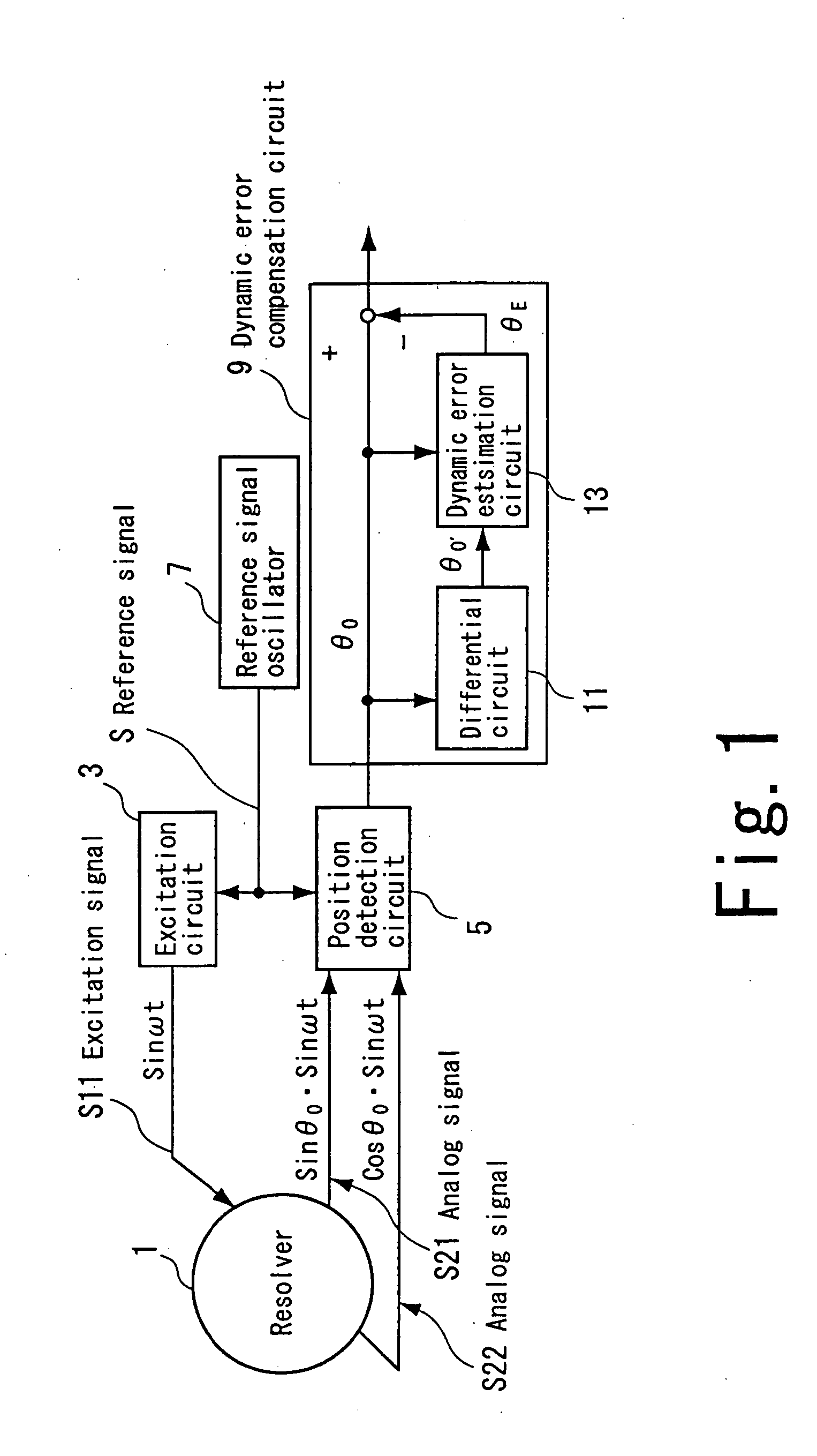[0009] The present invention aims at an improvement on a resolver detected position compensation method which performs a static error compensation on a resolver detected position by compensating a static error defined as an error from a real position of a rotor of the resolver that occurs when the rotor is at rest. This invention further performs a dynamic error compensation on the compensated detected position obtained by the static error compensation to eliminate a dynamic error defined as an error from a real position of the rotor that occurs when the rotor is rotating. The dynamic error means an error which, despite the static error compensation, occurs and varies as the rotor rotates. Performing the dynamic error compensation on the compensated detected position obtained by the static error compensation, as proposed in this invention, can eliminate the dynamic error that varies as the rotational speed of the rotor changes. This in turn enhances a resolver position detection accuracy. Particularly, according to this invention, even when the speed of the rotor of the resolver becomes high, the resolver position detection accuracy can be enhanced.
[0010] More specifically, whether the rotor is running at
low speed or at high speed (e.g., more than 10,000 min−1), the dynamic error includes twice as many ripples that appear during one rotation of the rotor as the number of pole pairs. So, performing a dynamic error compensation, which removes from the compensated detected position signal obtained by the static error compensation a dynamic
error signal that contains twice as many ripples that appear during one rotation of the rotor as the number of pole pairs of the resolver, can reliably eliminate the dynamic error from the compensated detected position signal.
[0011] Any desired method of dynamic error compensation may be employed. For instance, the dynamic error compensation may be executed as follows. First, a phase of a dynamic
error signal that varies according to the rotational position of the rotor is measured in advance at various rotational speeds of the rotor. Further, an amplitude
peak value of the dynamic error signal that varies with a speed of the rotor is measured beforehand at various rotational speeds of the rotor. Then, for a particular
rotor speed, the corresponding variation in phase and amplitude peak value of the dynamic error signal are multiplied to determine an estimated dynamic error. This estimated dynamic error is subtracted from the compensated detected position signal. With this method, the estimated dynamic error can be determined easily based on the variation in phase and amplitude peak value of the dynamic error signal, both measured beforehand at various speeds of the rotor. Simply subtracting the estimated dynamic error from the compensated detected position signal completes the dynamic error compensation. The entire process of the dynamic error compensation thus can be performed easily and reliably.
[0013] The dynamic error compensation circuit may be constructed to remove from the compensated detected position signal a dynamic error which includes twice as many ripples that appear during one rotation of the rotor as the number of pair poles of the resolver. More specifically, the dynamic error compensation circuit comprises: a phase
data memory means to store dynamic error phase data which is obtained by measuring beforehand a variation in phase of the dynamic error signal that varies according to the rotational position of the rotor at various rotational speeds of the rotor; a peak value memory means to store dynamic error amplitude peak value data which is obtained by measuring beforehand an amplitude peak value of the dynamic error signal that varies with the rotational speed of the rotor at various rotational speeds of the rotor; a differential circuit to determine the rotational speed by differentiating an output of the position detection circuit; a multiplication means to multiply the variation in phase and the amplitude peak value, read from the phase
data memory means and the peak value memory means respectively according to an output of the differential circuit, to determine an estimated dynamic error; and a subtraction circuit to subtract the estimated dynamic error from the compensated detected position signal. With this configuration the dynamic error compensation circuit can easily be formed.
[0014] As described above, by further performing a dynamic error compensation on the compensated detected position obtained by the static error compensation, the error that varies with a changing speed of the rotor can be compensated, improving the position detection precision over those of the conventional resolvers.
 Login to View More
Login to View More  Login to View More
Login to View More 


